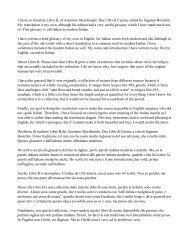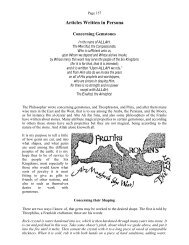How to Milk an Almond Stuff an Egg And Armor a Turnip A ...
How to Milk an Almond Stuff an Egg And Armor a Turnip A ...
How to Milk an Almond Stuff an Egg And Armor a Turnip A ...
Create successful ePaper yourself
Turn your PDF publications into a flip-book with our unique Google optimized e-Paper software.
143<br />
Pumpkin, Squash, Gourd<br />
It seems <strong>to</strong> be well established that at least three of the four cultivated species of Cucurbita (C.<br />
pepo, C. moschata <strong>an</strong>d C. maxima) existed in the New World long before Columbus; the fourth<br />
(C. ficifolia) is “ordinarily not thought of as a cultivated pl<strong>an</strong>t” (Whittaker), but apparently has<br />
been cultivated in the past. Whitaker argues, on the evidence of the absence of these species in<br />
the fifteenth century Europe<strong>an</strong> herbals <strong>an</strong>d their presence in the sixteenth century ones, that they<br />
were introduced in<strong>to</strong> Europe from the New World. A variety of C. pepo similar <strong>to</strong> the squash now<br />
known as “Small Sugar” is illustrated in <strong>an</strong> herbal of 1542. What appears <strong>to</strong> be a field pumpkin is<br />
illustrated in 1560, with other varieties appearing in later herbals during the century. Whitaker<br />
concludes that “none of the cultivated species of Cucurbita were known <strong>to</strong> the bot<strong>an</strong>ists of the<br />
Western world before 1492.” If so, all varieties of pumpkins, squash, <strong>an</strong>d vegetable marrows are<br />
inappropriate before 1492; some were known in the sixteenth century, but may or may not have<br />
been sufficiently common <strong>to</strong> be used in feasts.<br />
There is, however, a pl<strong>an</strong>t tr<strong>an</strong>slated as “gourd” in both Itali<strong>an</strong> <strong>an</strong>d Islamic cookbooks before<br />
1492. The Four Seasons of the House of Cerruti, which is 14th century, shows a “Cucurbite” that<br />
looks exactly like a green butternut squash–a fact of which Whitaker seems unaware when<br />
asserting the absence of all varieties of Cucurbita from pre-sixteenth century sources. It seems<br />
likely, however, that his conclusion was correct, <strong>an</strong>d that what is shown in the picture <strong>an</strong>d used in<br />
the recipes is not C. pepo but Lagenaria sicereia. For details see Paris et. al.<br />
“The white-flowered gourd, Lagenaria sicereia,” seems <strong>to</strong> “have been common <strong>to</strong> both Old<br />
<strong>an</strong>d New Worlds” (Whitaker). I am <strong>to</strong>ld that the Itali<strong>an</strong> Edible Gourd is a species of Lagenaria<br />
<strong>an</strong>d available from, among others, J. L. Hudson, Seedm<strong>an</strong> (www.jlhudsonseeds.net/). Simoons<br />
describes a Lagenaria still used in modern Chinese cooking. We have obtained what we think is<br />
the right gourd from a Chinese grocery s<strong>to</strong>re <strong>an</strong>d used it in period recipes with satisfac<strong>to</strong>ry<br />
results. The taste <strong>an</strong>d texture are somewhat similar <strong>to</strong> zucchini but less bitter. The Chinese, or<br />
perhaps Vietnamese, name for one variety, which the grower assured us had white flowers, is<br />
"opo."<br />
Pineapple <strong>an</strong>d Guava<br />
These are New World fruits that were being grown in India in the 16th Century (Crosby).<br />
Blueberry <strong>an</strong>d Cr<strong>an</strong>berry<br />
It appears from comments by Simmons that the term “blueberry” describes a number of<br />
different New World species of the genus Vaccinium; the bilberry, which is a member of the<br />
same genus, is Old World. The blueberry produces “larger <strong>an</strong>d better flavored berries th<strong>an</strong> the<br />
Europe<strong>an</strong> bilberry.” According <strong>to</strong> McGee, “The cultivated blueberry, a native of the Americ<strong>an</strong><br />
east, north, <strong>an</strong>d northwest, has been purposely bred only since about 1910 ... .”<br />
According <strong>to</strong> McGee, cr<strong>an</strong>berries are also species of Vaccinium. According <strong>to</strong> several earlier<br />
sources, there is disagreement as <strong>to</strong> whether they are members of Vaccinium or belong in a<br />
separate genus, Oxycoccus. There are both old world <strong>an</strong>d new world cr<strong>an</strong>berries, but “the<br />
commercial cr<strong>an</strong>berry ... is <strong>an</strong> Americ<strong>an</strong> native.” (McGee) The word “cr<strong>an</strong>berry” seems <strong>to</strong> have<br />
come in<strong>to</strong> use with the new world vari<strong>an</strong>t of the berry.<br />
It sounds, in both cases, as though a jelly made from modern berries would correspond pretty<br />
closely <strong>to</strong> something that might have been eaten in Europe in period, but individual berries would<br />
look noticably different from their old world relatives. We do not know of <strong>an</strong>y period recipes<br />
using either berry.





